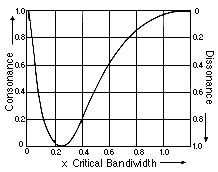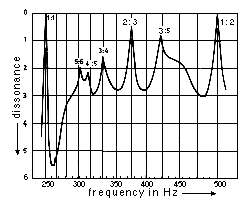|
|
The subjective agreeability of a sound or of simultaneous sounds. Opposite of DISSONANCE. Synonyms: HARMONY, concord. Compare: SONORITY.
The definition of which INTERVALs are consonant has changed remarkably throughout history, and varies among cultures. Traditionally in Western music only intervals that define simple frequency ratios (such as the OCTAVE 2:1, FIFTH 3:2, FOURTH 4:3, etc.) have been regarded as consonant, with those of less simple ratios being gradually accepted as time passed. It was assumed on the basis of this simple explanation that BEATS between the upper partials of tones caused the roughness of dissonance, and the coincidence of partials resulted in consonance.
This explanation, adopted by von Helmholtz, was extended recently when Plomp showed the relation between perceived consonance of tones and their action on the BASILAR MEMBRANE described by the CRITICAL BANDWIDTH. According to his theory, two tones become consonant when their frequency difference reaches the critical bandwidth, whereas the least consonance is observed at one-quarter of the critical bandwidth. On this basis, a curve of consonance for all tone-pairs within the octave was calculated (as shown below) which resulted in characteristic peaks at the unison, octave, fifth, fourth and so on, agreeing remarkably with the more empirical findings of von Helmholtz, Jeans and von Békésy.

Standard curve representing consonance of two simple tones as a function of frequency difference with critical bandwidth as a unit. The consonance and dissonance scales are arbitrary (from Plomp and Levelt, Journal of the Acoustical Society of America, vol. 38, p. 548ff, used by permission of the authors).

Illustration of the way in which consonance of an interval with a lower complex tone of 250 Hz and a variable higher one depends on the frequency of this tone. Both tones consist of 6 harmonics. The vertical lines represent interval width after the equal tempered scale (Plomp and Levelt, J.A.S.A., vol. 38, p. 548ff, used by permission of the authors).
home